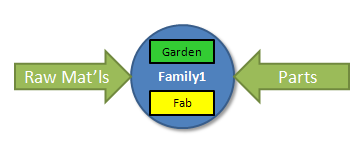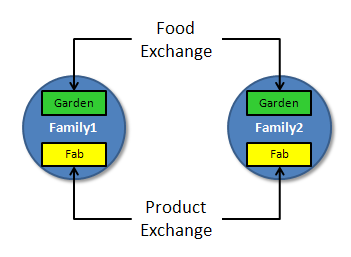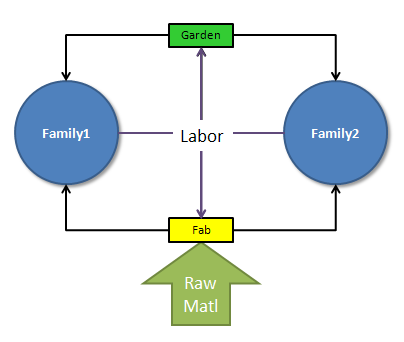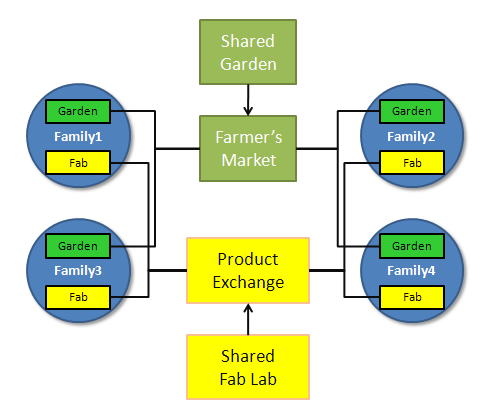OSEC Models of Cooperation: Difference between revisions
(Added text and notes.) |
(Initial analysis of individual and neighbor models.) |
||
| Line 2: | Line 2: | ||
=Self-Sufficiency= | =Self-Sufficiency= | ||
Even if a person or family unit is in complete agreement with OSE principles, local factors may force them into making a go of it themselves. As such, the model is one of self-sufficiency leveraging the GVCS were possible. | |||
[[Image:coop-1.png]] | [[Image:coop-1.png]] | ||
* | A garden is developed with food self-sufficiency in mind. This may include animal production as well. In order to have a sustainable food production capability, the family will need to: | ||
* save seeds | |||
* animal | * compost vegetable, scraps, and manure. | ||
* save seeds and propagate plants | |||
* breed animal to propagate them | |||
* plant perennial food crops (fruit and nut trees, vines, etc.) | |||
* preserve food for winter and lean months | |||
With self-sufficiency as a goal, the family will need to acquire a comprehensive set of tools to maintain their lifestyle. Ideally, these tools will include the fabrication tools included in the GVCS. Even given a good set of tools, the family will likely need to purchase external parts and products, thus creating a need for money (at least at this stage of civilization). This creates a whole set of secondary problems, many of them counter to self-sufficiency. | |||
* | Benefits of this model include: | ||
* | |||
* | * Lots of freedom | ||
* Reduced cost of living | |||
* Locally sustainable, to some degree | |||
Negative aspects of this model: | |||
* More risk, no help if something goes wrong | |||
* Need money to buy parts, products, and material | |||
* True self-sufficiency is difficult to attain | |||
* Labor requirements are large | |||
=Neighbors= | =Neighbors= | ||
In the neighbors model, two families that share OSE principles live close to each other, ideally adjacent. While the two families are independent of each other, they share and swap food and fabricated products. A certain amount of specialization arises as one family is better at producing something, and the other something else. | |||
[[Image:coop-2.png]] | [[Image:coop-2.png]] | ||
This model shares many of the aspects of the self-sufficiency model, but reduces risk and potentially reduces labor requirements. Furthermore, the waste stream of one might be utilized by the other. | |||
Model benefits: | |||
* Reduced risk | |||
* Social interactions | |||
* Further reductions in the cost of living | |||
* Increase pool of knowledge and skill | |||
* Allows for a small degree of specialization | |||
* Minimal distance for sharing and exchange | |||
Negative aspects: | |||
* | * A bit less freedom and privacy | ||
* | * No communal property, tools are not shared | ||
* | * Requires close cooperation, understanding, and communication | ||
=Communal Living= | =Communal Living= | ||
| Line 34: | Line 64: | ||
[[Image:coop-4.png]] | [[Image:coop-4.png]] | ||
Eco-village model? | |||
* some things made in homes | * some things made in homes | ||
Revision as of 14:53, 27 April 2011
Models of community cooperation vary somewhat by scale. Several models of cooperation are presented and analyzed here.
Self-Sufficiency
Even if a person or family unit is in complete agreement with OSE principles, local factors may force them into making a go of it themselves. As such, the model is one of self-sufficiency leveraging the GVCS were possible.
A garden is developed with food self-sufficiency in mind. This may include animal production as well. In order to have a sustainable food production capability, the family will need to:
- compost vegetable, scraps, and manure.
- save seeds and propagate plants
- breed animal to propagate them
- plant perennial food crops (fruit and nut trees, vines, etc.)
- preserve food for winter and lean months
With self-sufficiency as a goal, the family will need to acquire a comprehensive set of tools to maintain their lifestyle. Ideally, these tools will include the fabrication tools included in the GVCS. Even given a good set of tools, the family will likely need to purchase external parts and products, thus creating a need for money (at least at this stage of civilization). This creates a whole set of secondary problems, many of them counter to self-sufficiency.
Benefits of this model include:
- Lots of freedom
- Reduced cost of living
- Locally sustainable, to some degree
Negative aspects of this model:
- More risk, no help if something goes wrong
- Need money to buy parts, products, and material
- True self-sufficiency is difficult to attain
- Labor requirements are large
Neighbors
In the neighbors model, two families that share OSE principles live close to each other, ideally adjacent. While the two families are independent of each other, they share and swap food and fabricated products. A certain amount of specialization arises as one family is better at producing something, and the other something else.
This model shares many of the aspects of the self-sufficiency model, but reduces risk and potentially reduces labor requirements. Furthermore, the waste stream of one might be utilized by the other.
Model benefits:
- Reduced risk
- Social interactions
- Further reductions in the cost of living
- Increase pool of knowledge and skill
- Allows for a small degree of specialization
- Minimal distance for sharing and exchange
Negative aspects:
- A bit less freedom and privacy
- No communal property, tools are not shared
- Requires close cooperation, understanding, and communication
Communal Living
- can it be made equitable?
- group prioritization of production
- motivation?
Village Market
Eco-village model?
- some things made in homes
- others made in spec. fab unit
- abundance is shared
- shared values and goals are needed (potlatch)
- could be closed if resources are present
- exchange can sell outside if money is needed



